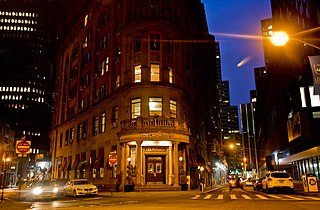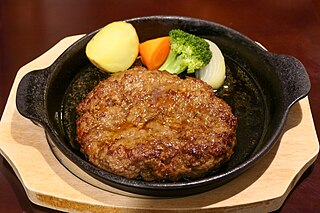
New England cuisine is an American cuisine which originated in the New England region of the United States, and traces its roots to traditional English cuisine and Native American cuisine of the Abenaki, Narragansett, Niantic, Wabanaki, Wampanoag, and other native peoples. It also includes influences from Irish, French, Italian, and Portuguese cuisine, among others. It is characterized by extensive use of potatoes, beans, dairy products and seafood, resulting from its historical reliance on its seaports and fishing industry. Corn, the major crop historically grown by Native American tribes in New England, continues to be grown in all New England states, primarily as sweet corn although flint corn is grown as well. It is traditionally used in hasty puddings, cornbreads and corn chowders.

Chowder is a thick soup prepared with milk or cream, a roux, and seafood or vegetables. Oyster crackers or saltines may accompany chowders as a side item, and cracker pieces may be dropped atop the dish. New England clam chowder is typically made with chopped clams and diced potatoes, in a mixed cream and milk base, often with a small amount of butter. Other common chowders include seafood chowder, which often consists of fish, clams, and other types of shellfish; lamb or veal chowder made with barley; corn chowder, which uses corn instead of clams; various fish chowders; and potato chowder, which is often made with cheese. Fish, corn, and clam chowders are popular in North America, especially Atlantic Canada and New England.

Fettuccine Alfredo or fettuccine al burro is an Italian pasta dish of fresh fettuccine tossed with butter and Parmesan. As the cheese melts, it emulsifies the liquids to form a smooth and rich cheese sauce coating the pasta. The dish is named after Alfredo Di Lelio, who featured the dish at his restaurant in Rome in the early to mid-20th century; the "ceremony" of preparing it tableside was an integral part of the dish.

Eggs Benedict is a common American breakfast or brunch dish, consisting of two halves of an English muffin, each topped with Canadian bacon, a poached egg, and hollandaise sauce. It was popularized in New York City.

The cuisine of New York City comprises many cuisines belonging to various ethnic groups that have entered the United States through the city. Almost all ethnic cuisines are well represented in New York, both within and outside the various ethnic neighborhoods.
Norwegian cuisine in its traditional form is based largely on the raw materials readily available in Norway and its mountains, wilderness, and coast. It differs in many respects from continental cuisine through the stronger focus on game and fish. Many of the traditional dishes are the result of using conserved materials, necessary because of the long winters.

Lobster Thermidor is a French dish of lobster meat cooked in a rich wine sauce, stuffed back into a lobster shell, and browned. The sauce is often a mixture of egg yolks and brandy, served with an oven-browned cheese crust, typically Gruyère. The sauce originally contained mustard.
The historical form of service à la russe is a manner of dining with courses brought to the table sequentially, and the food portioned on individual plates by the waiter. It contrasts with the older service à la française, based on several courses brought to the table simultaneously, in an impressive display of tureens and serving dishes, with diners plating food themselves.

Delmonico's is the name of a series of restaurants that operated in New York City, and Greenwich, Connecticut with the present version located at 56 Beaver Street in the Financial District of Manhattan. The original version was widely recognized as the America's first fine dining restaurant. Beginning as a small cafe and pastry shop in 1827 at 23 William Street, Delmonico's eventually grew into a hospitality empire that encompassed several luxury restaurants catering to titans of industry, the political elite and cultural luminaries. In many respects, Delmonico's represented the genesis of American fine dining cuisine, pioneering numerous restaurant innovations, developing iconic American dishes, and setting a standard for dining excellence. Delmonico's shuttered all locations by 1923. In 1926, Delmonico's under new ownership by Italian immigrant Oscar Tucci reopened at 56 Beaver Street.

Charles Ranhofer was the chef at Delmonico's Restaurant in New York from 1862 to 1876 and 1879 to 1896. Ranhofer was the author of The Epicurean (1894), an encyclopedic cookbook of over 1,000 pages, similar in scope to Escoffier's Le Guide Culinaire.

Pie à la Mode is pie served with ice cream. The French culinary phrase à la mode used in the name of this American dessert is also encountered in other dishes such as boeuf à la mode.

Steak Diane is a dish of pan-fried beefsteak with a sauce made from the seasoned pan juices. It was originally cooked tableside and sometimes flambéed. It was most likely invented in London in the 1930s. From the 1940s through the 1960s it was a standard dish in "Continental cuisine", and is now considered retro.

Hamburg steak is a patty of ground beef. Made popular worldwide by migrating Germans, it became a mainstream dish around the start of the 19th century. It is related to Salisbury steaks, which also use ground beef. It is considered the origin of the ubiquitous hamburger, when, in the early 20th century, vendors began selling the Hamburg steak as a sandwich between bread.
Bermudian cuisine reflects a rich and diverse history and heritage blending British and Portuguese cuisine with preparations of local seafood species, particularly wahoo and rockfish. Traditional dishes include codfish and potatoes served either with an add on of hard boiled egg and butter or olive oil sauce with a banana or in the Portuguese style with tomato-onion sauce, peas and rice. Hoppin' John, pawpaw casserole and fish chowder are also specialties of Bermuda. As most ingredients used in Bermuda's cuisine are imported, local dishes are offered with a global blend, with fish as the major ingredient, in any food eaten at any time.

Creamed eggs on toast is an American breakfast dish. It consists of toast or biscuits covered in a gravy made from béchamel sauce and chopped hard-boiled eggs. The gravy is often flavored with various seasonings, such as black pepper, garlic powder, celery salt, Worcestershire sauce, sherry, chopped parsley and/or chopped chives. The Joy of Cooking recommends making the bechamel with 1⁄2 cream and 1⁄2 chicken stock and adding capers or chopped pickle. As with many other dishes covered in light-colored sauce, a sprinkle of paprika or cayenne is often added as decoration.

The cuisine of New Orleans encompasses common dishes and foods in New Orleans, Louisiana. It is perhaps the most distinctively recognized regional cuisine in the United States. Some of the dishes originated in New Orleans, while others are common and popular in the city and surrounding areas, such as the Mississippi River Delta and southern Louisiana. The cuisine of New Orleans is heavily influenced by Creole cuisine, Cajun cuisine, and soul food. Later on, due to immigration, Italian cuisine and Sicilian cuisine also has some influence on the cuisine of New Orleans. Seafood also plays a prominent part in the cuisine. Dishes invented in New Orleans include po' boy and muffuletta sandwiches, oysters Rockefeller and oysters Bienville, pompano en papillote, and bananas Foster, among others.











